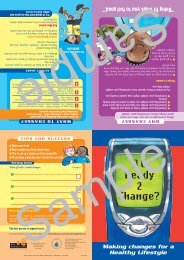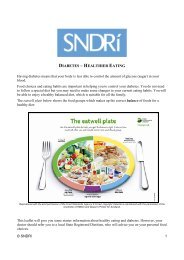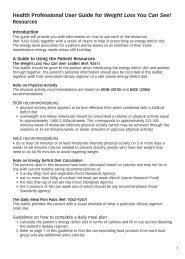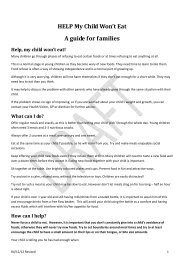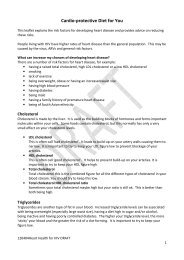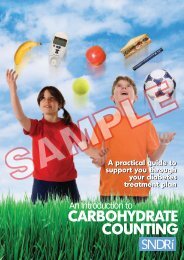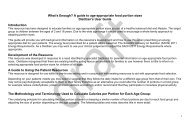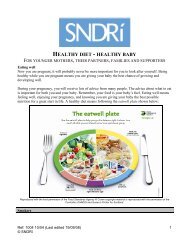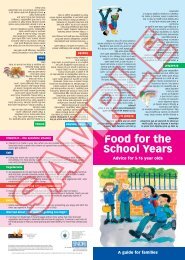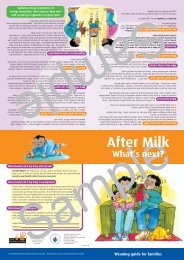IRON-DEFICIENCY ANAEMIA WHAT YOU EAT CAN HELP - NDR-UK
IRON-DEFICIENCY ANAEMIA WHAT YOU EAT CAN HELP - NDR-UK
IRON-DEFICIENCY ANAEMIA WHAT YOU EAT CAN HELP - NDR-UK
Create successful ePaper yourself
Turn your PDF publications into a flip-book with our unique Google optimized e-Paper software.
<strong>IRON</strong>-<strong>DEFICIENCY</strong> <strong>ANAEMIA</strong><br />
<strong>WHAT</strong> <strong>YOU</strong> <strong>EAT</strong> <strong>CAN</strong> <strong>HELP</strong><br />
What is iron-deficiency anaemia?<br />
Iron-deficiency anaemia occurs when the level of your red blood cells is low. This may be because<br />
your diet is too low in iron for your needs. Iron is a key ingredient for making red blood cells. Red<br />
blood cells carry oxygen around the whole of your body, so therefore, a low red blood cell count means<br />
less oxygen. This can leave you feeling tired, sometimes breathless and maybe a little dizzy.<br />
What can I do about it?<br />
If you are anaemic, your GP has probably prescribed iron tablets for you. Taking these tablets regularly<br />
and for as long as they are prescribed, gives you the best chance of improving your red blood cell level<br />
and feeling better. Nutrition is also very important. Increasing the amount of iron in your diet will play<br />
a big role in curing or preventing your anaemia.<br />
Which foods are rich in iron?<br />
Foods richest in iron are from animal sources. Offal e.g. liver, kidney etc. is especially good. Getting<br />
enough iron in your diet needs a little more effort, if you don’t eat meat. The information on the next<br />
page shows the best sources of iron. Non-meat choices, suitable for vegetarians, are also shown.<br />
So what should I eat?<br />
Eat as many foods rich in iron and Vitamin C as you can manage. Here are some ideas.<br />
Breakfast ideas<br />
• Fortified breakfast cereal and milk, with a glass of orange juice<br />
• Poached egg and baked beans with a glass of grapefruit juice<br />
• Wholemeal toast with marmalade or jam, and a kiwi fruit<br />
• Boiled egg with wholemeal bread fingers and half a grapefruit<br />
Lunch ideas<br />
• Liver pâté with wholemeal toast and salad<br />
• Corned beef and tomato sandwich<br />
• Baked beans on toast, with fruit to follow, or fruit juice<br />
• Broccoli quiche with salad and wholemeal bread and fruit juice<br />
• Mackerel in tomato sauce and toast<br />
• Lentil soup/broth with wholemeal roll and piece of fruit<br />
Main meal ideas<br />
• Liver, onion and tomato casserole with mashed potatoes and broccoli<br />
• Lamb cutlet and redcurrant jelly with potatoes, sprouts and carrots<br />
• Beef and vegetable stir fry with rice<br />
• Corned beef hash with broccoli and peas
• Omelette with baked potato, roasted peppers and courgettes<br />
• Beany casserole with garlic bread and mixed salad and fruit<br />
• Chick-pea and spinach bake with a tomato sauce, diced potatoes and green beans<br />
• Mince with potatoes and peas<br />
What about drinks?<br />
Make sure you drink 6-9 mugs/glasses of fluid a day (3-4 pints or 1½ -2 litres). Cold drinks rich in<br />
Vitamin C are especially good for helping absorb the iron. Have fruit juice (e.g. orange, grapefruit),<br />
tomato juice, vegetable juice or Vitamin C enriched cordials (e.g. blackcurrant).<br />
Hot drinks like tea, coffee and cocoa contain substances that reduce the absorption of iron from your<br />
food. Only drink these about an hour after eating, and between meals.
EXCELLENT SOURCES OF <strong>IRON</strong>: TRY<br />
TO <strong>EAT</strong> ONE PORTION OF THESE AT<br />
LEAST ONCE A WEEK<br />
VERY GOOD SOURCES OF <strong>IRON</strong>: TRY<br />
TO <strong>EAT</strong> 1-2 PORTIONS OF THESE<br />
EVERY DAY, IF <strong>YOU</strong> DON’T <strong>EAT</strong> ANY<br />
FOODS FROM THE ‘EXCELLENT’<br />
GROUP<br />
GOOD NON-M<strong>EAT</strong> SOURXES OF <strong>IRON</strong>:<br />
TRY TO <strong>EAT</strong> 2 PORTIONS OF THESE A<br />
DAY AND MORE IF <strong>YOU</strong> ARE A<br />
VEGETARIAN. THESE ARE ABSORBED<br />
BETTER WHEN <strong>EAT</strong>EN WITH FOODS<br />
RICH IN VITAMIN C<br />
Food Item Notes Food item Notes Food item Notes<br />
• Liver*<br />
• Liver pâté*<br />
• Kidney<br />
• Heart<br />
• Black pudding<br />
• Faggots<br />
If you’re not keen on<br />
offal, try chicken<br />
liver pate in a<br />
sandwich or on toast.<br />
It has a very mild<br />
flavour and is readily<br />
available in many<br />
supermarkets<br />
*Liver and liver<br />
products should be<br />
avoided in<br />
pregnancy. Their<br />
high vitamin A<br />
content may harm<br />
your baby<br />
• Red meat e.g. beef,<br />
lamb, pork or ham<br />
• Tongue<br />
• Corned beef<br />
• Sardines or<br />
mackerel<br />
• Fortified breakfast<br />
cereal**<br />
**Check the label and<br />
choose one with at<br />
least 8mg per 100g<br />
• Bread, especially<br />
wholemeal<br />
• Pulse vegetables<br />
e.g. beans, lentils,<br />
chick peas<br />
• Canned baked<br />
beans in tomato<br />
sauce<br />
• Eggs (4-6 a week)<br />
• Green leafy<br />
vegetables like<br />
broccoli, cabbage<br />
and spinach<br />
How can I make the iron work better?<br />
The iron in non-meat foods is less well absorbed than the iron in meaty foods. To boost the effect of iron in foods, eat them with foods rich<br />
in Vitamin C. Rich sources of vitamin C are:<br />
FOOD GROUP FOOD ITEMS<br />
Fruits e.g. oranges, grapefruit, strawberries, raspberries, blackcurrants, kiwi<br />
Juices e.g. fruit juice, tomato juice, vegetable juice<br />
Potatoes cooked any way – mashed, boiled, roasted, baked, sautéed, fried<br />
Vegetables e.g. sprouts, spinach, broccoli, peppers<br />
Cordial Vitamin-C enriched squash or diluting juice e.g. blackcurrant, orange
I’m vegetarian<br />
If you don’t eat meat, keeping your iron levels high is more difficult. The iron in non-meat foods is not<br />
as well absorbed as that in red meat and offal. The best way to help meet your iron needs is to eat at<br />
least one portion every day of each of these:<br />
- fortified breakfast cereal (with 8mg iron per 100g or more)<br />
- wholemeal bread<br />
- pulses like beans, peas or lentils<br />
- green leafy vegetables like broccoli, spinach or cabbage<br />
To boost the absorption of iron, eat Vitamin C rich fruit and vegetables with every snack or meal.<br />
I’m pregnant<br />
Being pregnant increases your body’s need for iron. Eat iron-rich foods from the lists in this leaflet as<br />
often as you can. During pregnancy, DO NOT <strong>EAT</strong> LIVER OR LIVER PRODUCTS such as pâté.<br />
They contain very high levels of Vitamin A, which may harm your baby.<br />
I’m still breastfeeding<br />
Breastfeeding and managing a young baby are two very tiring jobs, especially if you have other<br />
children too. To give your baby the best nourishment from your milk, eat as healthily as you possibly<br />
can. Following the advice in this leaflet will help boost your iron. Now you’re safe to start eating liver.<br />
Should everyone eat more iron?<br />
Iron-deficiency anaemia is quite common. If you’ve been feeling tired and know your diet isn’t quite<br />
what it could be, follow the advice in this leaflet. Those at particular risk of being anaemic are:<br />
- teenage girls<br />
- women in their 20s, 30s and 40s<br />
- women who are pregnant or breastfeeding<br />
- toddlers and children under 5 years<br />
- people who don’t eat meat<br />
- elderly people, especially those living alone<br />
If you feel tired, breathless or dizzy, ask your GP to check your iron levels.<br />
Can you get too much iron?<br />
You can safely increase the iron in your diet, but do not exceed the dose of iron tablets recommended.<br />
Iron supplements can be dangerous if taken in doses higher than recommended.<br />
This information has been produced for S<strong>NDR</strong>í by Registered Dietitians and other relevant health<br />
professionals. At the time of publication the information contained within the leaflet was, to the best of<br />
our knowledge, correct and up-to-date. Always consult a suitably qualified dietitian and/or your GP on<br />
health problems. S<strong>NDR</strong>í cannot be held responsible for how clients/patients interpret and use the<br />
information within this resource.<br />
Ref: 1000 10/04 (Last edited 19/09/08)<br />
© S<strong>NDR</strong>í<br />
4




